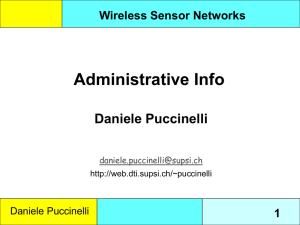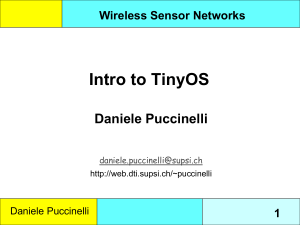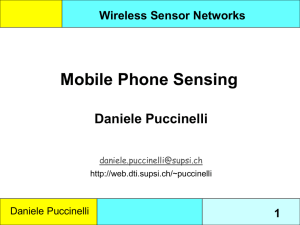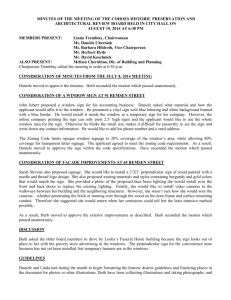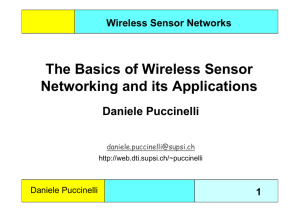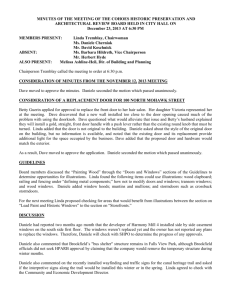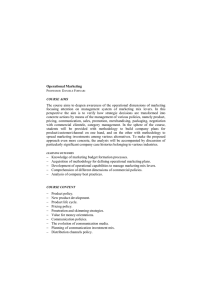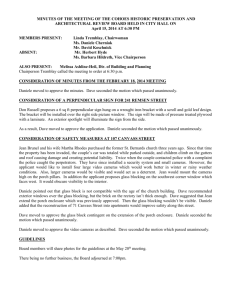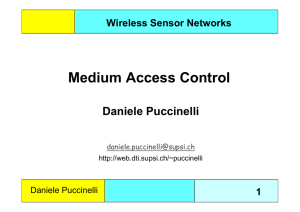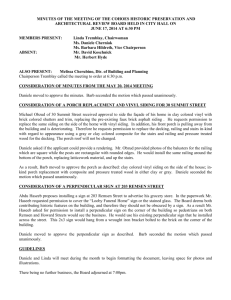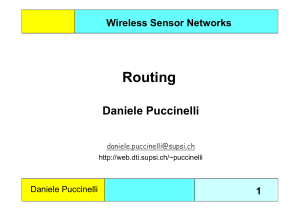Low-Power Wireless Links Daniele Puccinelli Wireless Sensor Networks 1
advertisement
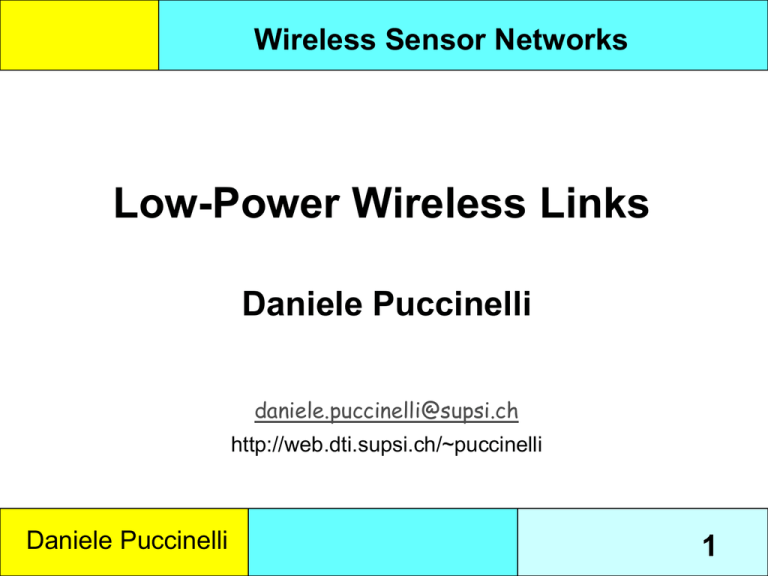
Wireless Sensor Networks Low-Power Wireless Links Daniele Puccinelli daniele.puccinelli@supsi.ch http://web.dti.supsi.ch/~puccinelli Daniele Puccinelli 1 Berkeley Motes Timeline René Mica and Mica2 MicaZ and Telos WeC Dot 1999 2000 2001 2002 Spec 2003 2004 Adapted from Joe Polastre, Designing Low-Power Wireless Systems Daniele Puccinelli 2 Inherent challenges • • • • Low-power radios are exposed to all sorts of RF phenomena Wireless links...an oxymoron? Single-hop or multi-hop? Even non-RF physical phenomena may impact communication Daniele Puccinelli 3 Disk Model? • No such thing for WSNs! • K. Seada et al., "Energy Efficient Forwarding Strategies for Geographic Routing in Wireless Sensor Networks," ACM Sensys 2004. • D. Ganesan et al., Complex Behavior at Scale: An Experimental Study of Low-Power Wireless Sensor Networks, UCLA Tech Rep 2002 Daniele Puccinelli 4 Dealing with RF • Low-power transceivers are even more vulnerable to the vagaries of RF propagation • Path loss: power loss due to distance between rx and tx • Shadowing: power loss due to the presence of an obstacle • Reflections: wave hits a surface and part of the energy bounces back, part goes through • Fading: several reflected paths make it to the rx Daniele Puccinelli 5 Flavors of Fading Dynamic Fading o Nodes in motion relative to one another o Fading patterns naturally change o Comes with changes in the path loss as well Static Fading o Fading patterns change only if the area layout changes Induced Fading o Fading patterns are temporarily modified by the motion of people or objects Daniele Puccinelli 6 RF propagation fading (!) fading different static fading levels shadowing Daniele Puccinelli 7 Multipath fading revolution period impact of fading: 40dB!!! Indoors, fading can dominate over the path loss Daniele Puccinelli 8 Induced Fading 0 1 2 E1 Chair moved close to node 1 E2 Person through (2, 0) E3 Chair moved close to node 2 Daniele Puccinelli 9 Impact of Induced Fading A Induced Fading B Dynamic Fading + Path Loss Daniele Puccinelli 10 Impact on Higher-End Radios • Fading is still there but • May use higher power • Better Sensitivity CISCO Aironet 350 11Mbps => -85 dBm 5.5 Mbps => -89 dBm 2 Mbps => -91 dBm 1 Mbps => -94 dBm Daniele Puccinelli 11 Sensorless Motion Detection A Erratic motion detected by accelerometer B Accelerometer can’t make it, RSS can! Daniele Puccinelli 12 Low-power wireless links A B Links are NOT Boolean: If B can hear A once, it doesn’t mean they’re connected Links are NOT bidirectional: if A can hear B, B doesn’t necessarily hear A Links are probabilistic: B can hear A with a given probability In practice, a link can be characterized in terms of •Received Power (RSS) •Packet Delivery Rate (PDR) •Required Number of Packets (RNP) Daniele Puccinelli 13 Transitional links solid links (PDR>0.8) transitional links RSS range between -95 and -80dBm where PDR has a huge variance Asymmetric links all lie within this region disconnected links below -95dBm, PDR is virtually 0 Daniele Puccinelli 14 Transitional Can Become Disconnected Shadowing! Daniele Puccinelli 15 PDR vs. RSS Daniele Puccinelli 16 RNP: the cost of using a link A B Node A sends, B does not receive, no ACK: RNP ≥ 2 A B Node A resends, B does not receive, no ACK: RNP ≥ 3 A B Node A resends, B receives, ACK is lost: RNP ≥ 4 A B Node A resends, B receives, ACK is received: RNP = 4 Daniele Puccinelli 17 Connectivity • Definitely not circular • Blobs of connectivity • Being close doesn’t necessarily mean being connected (fading!) A B connected to A Daniele Puccinelli connected to B 18 Single-hop or multihop? A B C Do we use (A, C)? connected to C connected to A Daniele Puccinelli Or do we use (A, B) and (B, C)? 19 Multihopping Nodes need to relay on behalf of others... ...but relaying is not free: • energy cost • risk of packet loss • B works for free on behalf of A • Extra energy cost for B • Packet may get lost on (A, B) and on (B, C) A Hey, B, this is for C B Daniele Puccinelli Do I really have to??? C 20 Benefits of a few long hops •Less radio activity: less interference •Tx power reduction does not yield proportional energy savings •Not relaying means you can sleep! •Less overhead •Energy balancing When multihopping: • if any of the links breaks, the end-to-end route breaks • if any of the relays moves, the route is endangered Daniele Puccinelli 21 Impact of non-RF phenomena Temperature has a huge impact on received signal strength Wireless Sensor Networking for “Hot” Applications: Effects of Temperature on Signal Strength, Data Collection and Localization K. Bannister, G. Giorgetti and S.K.S. Gupta, HotEmNets’08 Daniele Puccinelli 22 Reading List 1. M. Zuniga, B. Krishnamachari, "An analysis of unreliability and asymmetry in low-power wireless links", ACM Transactions on Sensor Networks, Jun. 2007 2. K. Srinivasan, P. Dutta, A. Tavakoli, and P. Levis, “An Empirical Study of Low-Power Wireless”, ACM Transactions on Sensor Networks, Feb. 2010 Daniele Puccinelli 23
